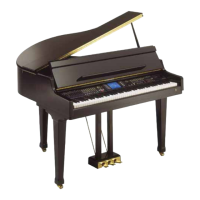○○○○○○○○○○○○○○○○○○○○○○
2•16 Reference Guide
○○○○○○○○○○○○○○○○○○○○○○
2•16 Reference Guide
An Algorithm is the “signal path” of a sample to
the audio outputs, through a series of process-
ing functions that you select during the course of
the editing tasks. The processing functions which
you assign during the various editing stages are
the synthesis tools (oscillators, filters, amplitude
envelopes, etc.).
While you cannot change the path of an Algo-
rithm, you can choose from a selection of 5 dif-
ferent Algorithms, each representing a fixed sig-
nal path, and assign a wide variety of processing
functions to the individual stages of the algo-
rithm’s path.
The following graphical representations illustrate
the signal path of the Algorithms.
SINGLE
A Volume, Amplitude envelope, Filter and Pitch envelope for
one waveform only.
DUAL 1
Separate Volume, Amp Envelope, Filter and Pitch Envelope for
each waveform.
DUAL 2
As above but the two filters are in series and common to both
waveforms.
DUAL 3
Volume and Amp. Envelope are common while
filters are separate for each waveform
DUAL 4
Everything is common to both waveforms.
An Algorithm is the “signal path” of a sample to
the audio outputs, through a series of process-
ing functions that you select during the course of
the editing tasks. The processing functions which
you assign during the various editing stages are
the synthesis tools (oscillators, filters, amplitude
envelopes, etc.).
While you cannot change the path of an Algo-
rithm, you can choose from a selection of 5 dif-
ferent Algorithms, each representing a fixed sig-
nal path, and assign a wide variety of processing
functions to the individual stages of the algo-
rithm’s path.
The following graphical representations illustrate
the signal path of the Algorithms.
SINGLE
A Volume, Amplitude envelope, Filter and Pitch envelope for
one waveform only.
DUAL 1
Separate Volume, Amp Envelope, Filter and Pitch Envelope for
each waveform.
DUAL 2
As above but the two filters are in series and common to both
waveforms.
DUAL 3
Volume and Amp. Envelope are common while
filters are separate for each waveform
DUAL 4
Everything is common to both waveforms.
○○○○○○○○○○○○○○○○○○○○○○
2•16 Reference Guide
○○○○○○○○○○○○○○○○○○○○○○
2•16 Reference Guide
An Algorithm is the “signal path” of a sample to
the audio outputs, through a series of process-
ing functions that you select during the course of
the editing tasks. The processing functions which
you assign during the various editing stages are
the synthesis tools (oscillators, filters, amplitude
envelopes, etc.).
While you cannot change the path of an Algo-
rithm, you can choose from a selection of 5 dif-
ferent Algorithms, each representing a fixed sig-
nal path, and assign a wide variety of processing
functions to the individual stages of the algo-
rithm’s path.
The following graphical representations illustrate
the signal path of the Algorithms.
SINGLE
A Volume, Amplitude envelope, Filter and Pitch envelope for
one waveform only.
DUAL 1
Separate Volume, Amp Envelope, Filter and Pitch Envelope for
each waveform.
DUAL 2
As above but the two filters are in series and common to both
waveforms.
DUAL 3
Volume and Amp. Envelope are common while
filters are separate for each waveform
DUAL 4
Everything is common to both waveforms.
An Algorithm is the “signal path” of a sample to
the audio outputs, through a series of process-
ing functions that you select during the course of
the editing tasks. The processing functions which
you assign during the various editing stages are
the synthesis tools (oscillators, filters, amplitude
envelopes, etc.).
While you cannot change the path of an Algo-
rithm, you can choose from a selection of 5 dif-
ferent Algorithms, each representing a fixed sig-
nal path, and assign a wide variety of processing
functions to the individual stages of the algo-
rithm’s path.
The following graphical representations illustrate
the signal path of the Algorithms.
SINGLE
A Volume, Amplitude envelope, Filter and Pitch envelope for
one waveform only.
DUAL 1
Separate Volume, Amp Envelope, Filter and Pitch Envelope for
each waveform.
DUAL 2
As above but the two filters are in series and common to both
waveforms.
DUAL 3
Volume and Amp. Envelope are common while
filters are separate for each waveform
DUAL 4
Everything is common to both waveforms.

